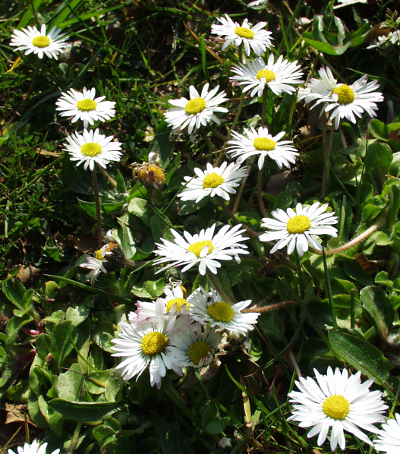Bellis |

In sunny weather, the flower heads are wide open
Bellis emerged first at Pliny (about 23–79 B.C.), and is designated as a white to reddish meadow plant. Linné described the species scientifically in 1753.
The name "Daisy" is derived from the Old English "dćgesege" what means "day's eye". This refers to the opening of the flower at dawn. In addition to the common daisy e.g. Leucanthemum vulgare, Ismelia carinata, Brachyscome iberidifolia and the members of the genus Globularia are called "daisies".
Comprising about 15 species, the genus Bellis is native to the temperate zone of the northern hemisphere, with a focus on the Mediterranean. The annual to perennial plants form a basal rosette with spatulate, obovate or rounded leaves, which are stalked, entire, notched or serrated. Stem leaves are often missing or reduced. If present, then they are arranged spirally. The stem is erect, usually unbranched and hairy.
The flower heads are arranged solitary at the tip of the stem or in axillary lateral shoots. The 60 to about 80 tubular flowers in the middle of the head are bisexual, 5-dentate and yellow, the 35–90 marginal, narrow ray florets are female, 2-dentate or slightly emarginate, white, pink, red or blue and arranged in one or up to 4 rows. The receptacle is domed or conical, pitted and without chaffy leaves. The approximately 14 elongated, thin and herbaceous phyllaries are about the same shape and are arranged in 1–3 rows to form a hemispherical or wide bell-shaped involucre.
After insect or self-pollination the inferior ovary forms an egg-shaped nut fruit (achene), which is strongly flattened and shows 2 ribs on both sides. Fruits at the tip without a pappus or with very short bristles that are fused at the base.
| Floral formula: |
| ↓ K0 C(5) G(2) inferior
and * K0 [C(5) A5(connate)] G(2) inferior |
Meaning of the species name
- perennis: lat. perennis = perennial, hardy
Interesting notes
-
Double flowered varieties of Bellis perennis are traded as ornamental plants.
-
The daisy survives in dry weather temperatures until -15 °C.